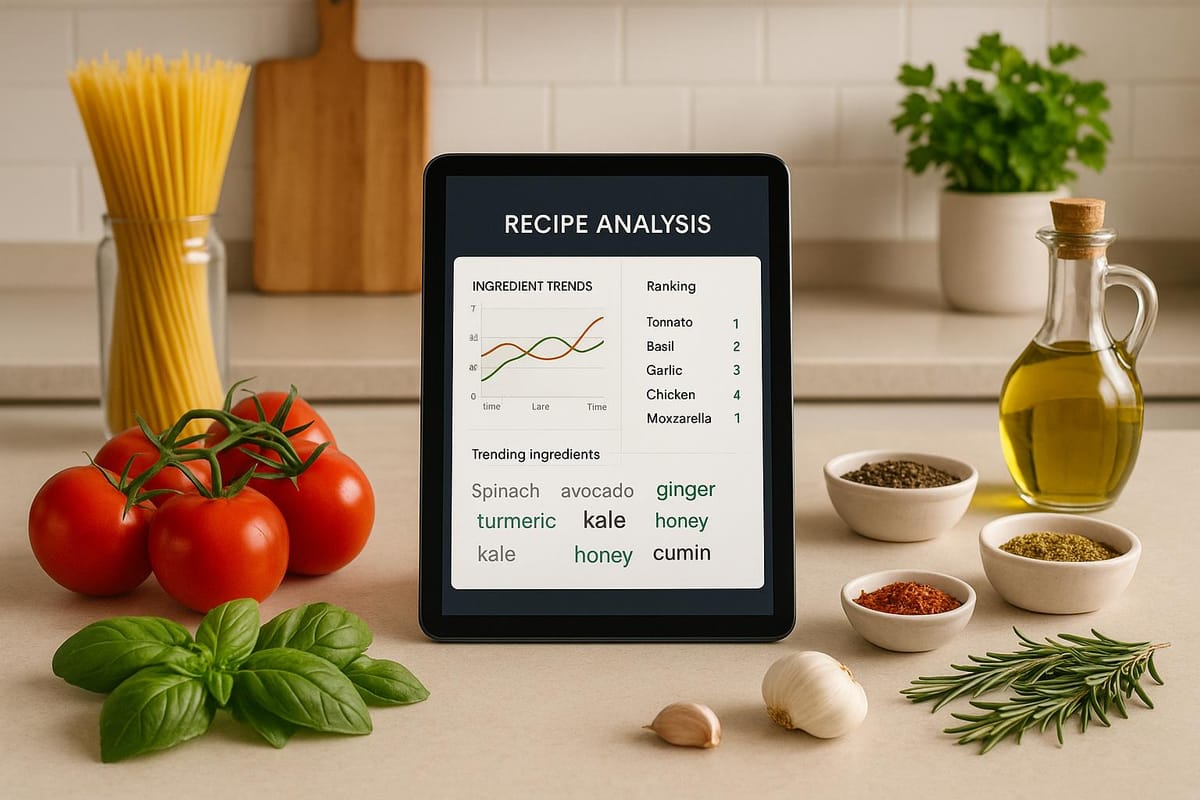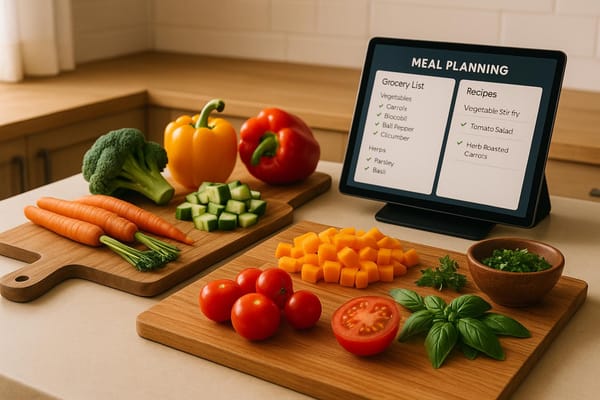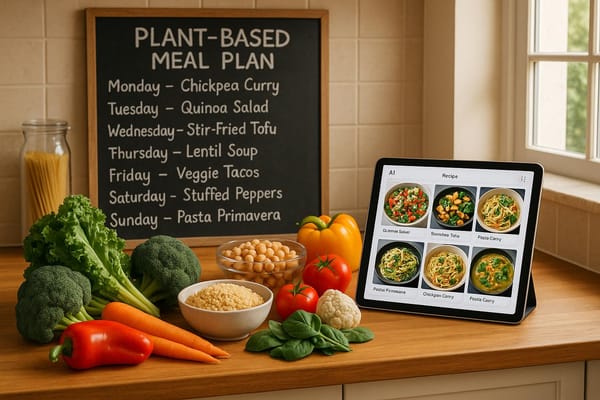How AI Tracks Ingredient Trends in Recipes
Explore how AI analyzes ingredient trends in recipes, helping cooks save time and reduce waste while keeping meals fresh and exciting.

Artificial intelligence is transforming how we identify ingredient trends in recipes. By analyzing data from social media, restaurant menus, and food blogs, AI identifies what’s popular in real-time. This technology isn’t just about tracking trends - it’s helping home cooks save time, reduce waste, and try new ideas.
Key Takeaways:
- AI analyzes billions of social media posts, recipes, and menus to spot ingredient trends.
- Tools like Honeydew Recipe Manager simplify meal planning by turning trending recipes into grocery lists.
- Real-time data ensures AI captures viral food trends as they happen.
- Predictive models forecast which ingredients will gain popularity, helping cooks stay ahead.
AI-powered tools are reshaping meal planning, making it easier to discover and cook with trending ingredients while saving money and reducing waste.
Recipe Analytics: New AI-Powered Insights for Food Brands on Shopify
How AI Collects Ingredient Data
AI systems pull ingredient data from a variety of digital sources, painting a detailed and up-to-date picture of what's trending in U.S. kitchens.
Where AI Gets Its Data
Social media platforms like Instagram and TikTok generate millions of food-related posts daily. AI uses image recognition to analyze captions, hashtags, and comments, extracting ingredient details from this flood of content.
Platforms like Tastewise take this a step further, analyzing billions of interactions on social media to track trending hashtags and ingredient mentions as they happen. This kind of analysis helps food companies identify which ingredients are gaining traction.
Another key player is Honeydew Recipe Manager, which processes around 22,000 recipes each month. This platform provides organized ingredient data that reflects what people are cooking at home.
Restaurant menus also offer valuable insights. By scanning menus from across the country, AI systems can spot innovative ingredient pairings and seasonal trends, identifying what's new and exciting in the professional culinary world.
Customer reviews add another layer of depth. By analyzing ratings, comments, and feedback, AI can gauge how consumers feel about specific ingredients, distinguishing between passing fads and those with staying power.
AI systems handle both structured and unstructured data. Recipe databases provide neatly organized ingredient lists, while social media content demands more advanced techniques to make sense of casual posts and artistic food photography. This dual approach ensures a comprehensive understanding of ingredient trends.
The continuous nature of this data collection ensures that insights are always current and relevant.
Why Real-Time Data Matters
Real-time data collection enables AI to quickly capture viral recipes, seasonal trends, and popular hashtags - far faster than traditional research methods.
This speed is crucial because trends can emerge and fade almost overnight. For example, a viral TikTok food challenge can suddenly make a little-known ingredient wildly popular. Real-time data allows meal planning apps to recommend recipes featuring these trending ingredients while they’re still in the spotlight.
Honeydew Recipe Manager demonstrates this real-time capability with its "Import From Social" feature. This tool lets users turn their favorite food posts from social media into instant recipes, making it easier for home cooks to stay on trend.
By cross-referencing data from multiple sources - like social media, restaurant menus, and recipe databases - AI systems can more accurately predict which ingredients are poised for widespread adoption.
Real-time, continuous data collection also means that AI can adjust to evolving preferences, ensuring meal planning recommendations stay aligned with current tastes. This dynamic process is what makes AI-driven insights both timely and actionable.
AI Methods for Recipe Analysis
After gathering ingredient data from a variety of sources, AI systems use advanced techniques to make sense of all this information. When it comes to analyzing ingredient trends, AI typically relies on three main approaches to uncover patterns and predict what’s next in American kitchens.
Machine Learning for Pattern Detection
AI uses machine learning to dig deep into recipe databases, uncovering patterns that would be impossible for humans to spot manually. These algorithms analyze ingredient combinations, how often they’re used, and how their popularity changes over time. For example, machine learning might reveal that oat milk is becoming a go-to dairy substitute in baking or that turmeric is gaining traction in health-conscious recipes.
Techniques like clustering group similar recipes together, while classification methods sort ingredients based on how they’re used. Time-series analysis adds another layer by tracking how ingredient popularity shifts during seasons, holidays, or special events. AI even taps into chemical property and flavor compound analysis to suggest unexpected ingredient pairings - like combining cardamom with apple pie. By processing both structured data from recipe databases and unstructured content from social media, these systems capture insights from traditional cooking and viral food trends alike.
Natural Language Processing in Recipes
To complement pattern detection, AI leverages natural language processing (NLP) to extract detailed information from recipes. NLP enables AI to understand recipe content at scale, pulling out ingredient lists, quantities, preparation methods, and even context from text, images, and videos. For instance, if someone posts a recipe on Instagram and casually says, "toss in some fresh basil" or "add a splash of balsamic", NLP algorithms can identify the ingredients and estimate quantities, even from this informal language.
Advanced NLP models can also analyze visual content from platforms like TikTok, identifying ingredients directly from videos to refine trend analysis. Tools like Honeydew Recipe Manager bring this capability to life with features like "Import From Social", which turns viral recipe videos into structured meal plans. It extracts ingredient details, creates smart shopping lists, and even suggests substitutes when needed. NLP also allows for recipe translation, making global ingredient trends accessible to American cooks. On top of that, sentiment analysis of user reviews helps separate passing fads from trends with staying power.
Predicting Future Ingredient Trends
Predictive modeling is the cutting-edge of AI recipe analysis, using historical data and real-time signals to forecast which ingredients will rise in popularity. These models simulate how ingredients interact and optimize recipes to match evolving dietary preferences. Platforms like Tastewise analyze massive amounts of data from social media, restaurant menus, and consumer habits to pinpoint growing interest in specific ingredients.
Kellanova’s food scientists take this a step further by combining Tastewise data with Microsoft’s AI tools to uncover localized consumer insights, speeding up product development. Predictive models also factor in seasonal trends, cultural events, and health movements. Apps like Honeydew Recipe Manager use these forecasts to update meal suggestions in real time, offering recipes with trending ingredients before they hit their peak.
Using AI Ingredient Trends in Meal Planning
AI is changing the way we approach meal planning by turning ingredient trends into tailored solutions that save time, reduce food waste, and keep meals interesting. With smart tools that adapt to your lifestyle and dietary needs, AI brings trending ingredient data straight to your kitchen.
Custom Recipe Suggestions
AI-powered meal planners can recommend recipes that align with your dietary preferences, cooking habits, and nutrition goals. By blending trending ingredients with your personal needs, these platforms make meal planning both practical and exciting.
Take the Honeydew Recipe Manager, for example. This app pulls trending recipes from social media and customizes meal plans based on your preferences. Whether you’re looking for "Quick & Easy", "Vegetarian", or "Family Favorite" dishes, the AI organizes recipes to match your style. If cauliflower-based dishes are trending and you’re into low-carb meals, it might suggest a cauliflower pizza crust recipe that checks both boxes.
But it doesn’t stop there. AI can even recommend recipes based on what’s already in your pantry, cutting down on waste and helping you save money. As one user shared:
"The smart grocery lists save me hundreds of dollars a month. I love how it suggests recipes based on what I already have!" - James L., @james_student
A great example of AI’s potential comes from Knorr's "Eat Your Feed" campaign. By analyzing users' Instagram posts, it recommended recipes tailored to trending ingredients and seasonal contexts. Think cozy soups for winter vacations and fresh salads for summer getaways. This approach boosted user engagement by 65% and encouraged repeat visits.
Simplified Grocery Shopping
AI also makes grocery shopping easier by turning recipe data into detailed shopping lists. Instead of manually jotting down items and risking forgotten ingredients, AI-generated lists include precise quantities in familiar U.S. measurements like cups, ounces, and pounds.
Honeydew Recipe Manager takes this a step further by creating complete grocery lists and even suggesting substitutes when needed. With its direct Instacart integration, you can order everything you need with just one click, making the process from meal planning to ingredient delivery seamless.
This smarter shopping approach has real benefits. Many users have reported significant savings, as one user explained:
"I used to waste so much food. Now with Honeydew's meal planning, I buy exactly what I need and save money!" - Mark T., @mark_cook
What’s more, the AI considers factors like seasonal availability and local pricing trends. This ensures your shopping list reflects what’s fresh, accessible, and affordable in your area, helping you make the most of trending ingredients when they’re at their best.
Team Meal Planning and Nutrition Tracking
Meal planning isn’t just for individuals - it’s a team effort in many households. Modern AI tools are designed to handle the complexities of family meal routines, balancing different preferences, dietary restrictions, and nutritional needs.
With the Honeydew Recipe Manager, families can plan meals collaboratively. Its Plus plan supports up to six members, allowing everyone to contribute their input. Whether one person is vegetarian, another needs extra protein, or someone requires gluten-free options, the AI adapts to accommodate everyone.
On top of that, nutrition tracking helps families stay on top of their health goals. The app breaks down daily intakes of calories, protein, carbs, fat, and fiber, making it easier to monitor dietary needs. This feature is especially helpful for households managing specific health conditions, with users reporting a 50% improvement in dietary compliance when using AI-driven platforms.
The collaborative features go beyond meal selection. Family members can rate recipes, share feedback, and refine preferences, allowing the AI to learn and improve over time. With 22,000 recipes saved monthly and a 4.8-star rating, these tools are making meal planning more efficient, budget-friendly, and enjoyable for families across the U.S..
Pros and Cons of AI Ingredient Tracking
AI ingredient tracking, like any technological tool, has its strengths and weaknesses. Knowing these can help you decide how to incorporate it into your cooking routine.
Benefits of AI Ingredient Analysis
AI can analyze massive amounts of data - billions of data points - up to 40% faster than manual methods. While traditional approaches are slow and require significant effort, AI can instantly process information from sources like social media, restaurant menus, and home recipes.
Its ability to predict ingredient trends is also noteworthy. Platforms like Tastewise analyze culinary data on a large scale, helping food companies stay ahead of consumer preferences. For home cooks, this means access to trending recipes and ingredients as they gain popularity.
Scalability is another area where AI shines. Unlike food experts, who can only track a limited number of ingredients, AI systems monitor thousands of ingredients across millions of online posts, menus, and websites simultaneously. This capability makes it easier to spot emerging trends early.
AI also offers cost-saving benefits. Businesses using AI for ingredient optimization have reported up to a 25% reduction in ingredient costs by cutting waste and improving ingredient combinations. For everyday cooks, this means smarter grocery shopping, better meal planning, and less food waste. Tools like the Honeydew Recipe Manager demonstrate how this efficiency can enhance user satisfaction.
Challenges and Drawbacks
However, AI ingredient tracking isn’t without its challenges. One major issue is data bias. Many systems tend to focus on popular cuisines or widely documented ingredients, often overlooking niche or culturally specific trends.
Regional differences in ingredients can also be problematic. AI may suggest expensive imported items instead of affordable local alternatives, failing to account for seasonal availability or local preferences.
Privacy concerns are another drawback. AI platforms often collect personal data from your social media activity, shopping habits, and recipe preferences. This raises questions about how that data is stored and used.
Cultural sensitivity is also a limitation. Sometimes, AI-generated recipes lack an understanding of the cultural significance of certain ingredients or cooking methods, which can lead to suggestions that feel out of touch or inappropriate.
The global food technology market highlights both the promise and challenges of AI in cooking. Valued at $183.5 billion in 2023, it’s projected to grow to $354.9 billion by 2030. This rapid expansion reflects the demand for AI culinary tools, but it also underscores the need to address these limitations.
| Aspect | Benefits | Drawbacks |
|---|---|---|
| Speed | 40% faster trend identification | May overlook slow-developing niche trends |
| Accuracy | Real-time data from billions of sources | Can favor popular ingredients over others |
| Personalization | 45% improvement in user satisfaction | Struggles with cultural nuances |
| Cost | 25% reduction in ingredient costs | Raises privacy concerns with data use |
| Coverage | Tracks global ingredient trends | Gaps in regional availability |
These pros and cons highlight the potential of AI to transform meal planning while pointing to areas where improvement is needed.
How AI Changes Meal Planning with Ingredient Trends
AI is reshaping meal planning by turning trending ingredients into actionable meal ideas. Forget spending hours scrolling for inspiration - AI-powered platforms now sift through massive amounts of data to recommend meals that align with both food trends and your personal tastes. This shift marks the beginning of a new, streamlined era of meal planning, driven by automation and trends.
Instead of getting stuck between inspiration and execution, users can now move seamlessly from seeing a viral recipe to making it part of their weekly plan. Take Honeydew Recipe Manager, for instance - it allows users to import popular recipe videos straight from social media and turn them into structured meal plans in seconds. The platform processes thousands of recipes monthly, showcasing how AI bridges the gap between trending content and practical cooking.
"Turn viral recipe videos into your weekly meal plan - fast, fun, and totally stress-free." - Honeydew Recipe Manager
The real breakthrough is AI's ability to automate the entire meal planning process. By linking social media trends with practical recipe suggestions, AI personalizes meal planning in ways that were unimaginable before.
These tools go beyond just picking recipes. Modern AI platforms create complete meal planning systems. They generate precise grocery lists, recommend ingredient swaps when trendy items are unavailable, and even integrate with services like Instacart for one-click ordering. This kind of automation tackles the biggest challenges of meal planning: deciding what to cook, figuring out how much to buy, and shopping for ingredients.
AI has also made meal planning more collaborative. Many platforms now allow household sharing for up to six members, so everyone can input their preferences. The AI then adapts trending recipes to meet diverse dietary needs. This feature has led to a 50% increase in dietary compliance for users managing specific health conditions, as the AI ensures that even trendy recipes align with individual nutrition goals.
Another major perk? Cost savings. AI optimizes grocery lists to reduce food waste and suggests recipes based on what you already have at home. Add in automatic calorie and nutrition tracking, and you’ve got a tool that helps you stay on trend, save time, and cut costs.
With the global food technology market projected to grow from $183.5 billion in 2023 to $354.9 billion by 2030, AI-driven meal planning is becoming a cornerstone of modern cooking. This growth reflects a shift happening in kitchens across the country. Cooking is no longer about rigid recipes - it’s about having a smart assistant that keeps up with food trends, understands your preferences, and simplifies the entire process.
FAQs
How does AI identify lasting ingredient trends versus short-lived food fads?
AI can tell the difference between fleeting food fads and enduring ingredient trends by diving into massive amounts of recipe data from places like social media, food blogs, and online recipe hubs. It identifies patterns by tracking how often certain ingredients show up, how their popularity shifts over time, and whether they’re consistently featured across different cuisines and meal types.
Take, for instance, an ingredient that suddenly becomes popular but fades away just as quickly - it’s likely a fad. On the other hand, an ingredient that gradually gains traction across various dishes and contexts points to a trend with staying power. Using sophisticated algorithms, AI uncovers these shifts in food preferences, enabling tools like Honeydew Recipe Manager to stay ahead of the curve. This means smarter meal-planning options that align with what people are genuinely craving.
Does AI tracking ingredient trends on social media raise privacy concerns?
AI systems designed to track ingredient trends on social media generally rely on publicly accessible data. This includes information like recipe posts, popular hashtags, and shared content. They don’t access private or personal details unless those are voluntarily shared in public spaces.
That said, it’s always wise to stay informed. Privacy policies and data usage practices can differ widely between platforms and tools. To understand how your data might be collected or processed, take the time to review the privacy policies of the social media platforms you use as well as any AI tools involved.
How does AI meal planning with tools like Honeydew Recipe Manager reduce food waste and save money?
AI-powered tools, such as the Honeydew Recipe Manager, make it easier to cut down on food waste and save money. By generating precise grocery lists tailored to your meal plans, these tools ensure you only purchase what’s necessary. They also recommend ingredient substitutions, helping you use what’s already in your kitchen and avoid extra spending.
Honeydew Recipe Manager simplifies meal planning with features like drag-and-drop scheduling and one-click ingredient ordering through Instacart. This not only saves time but also helps you stay on track with your budget, making meal prep more efficient and stress-free.




